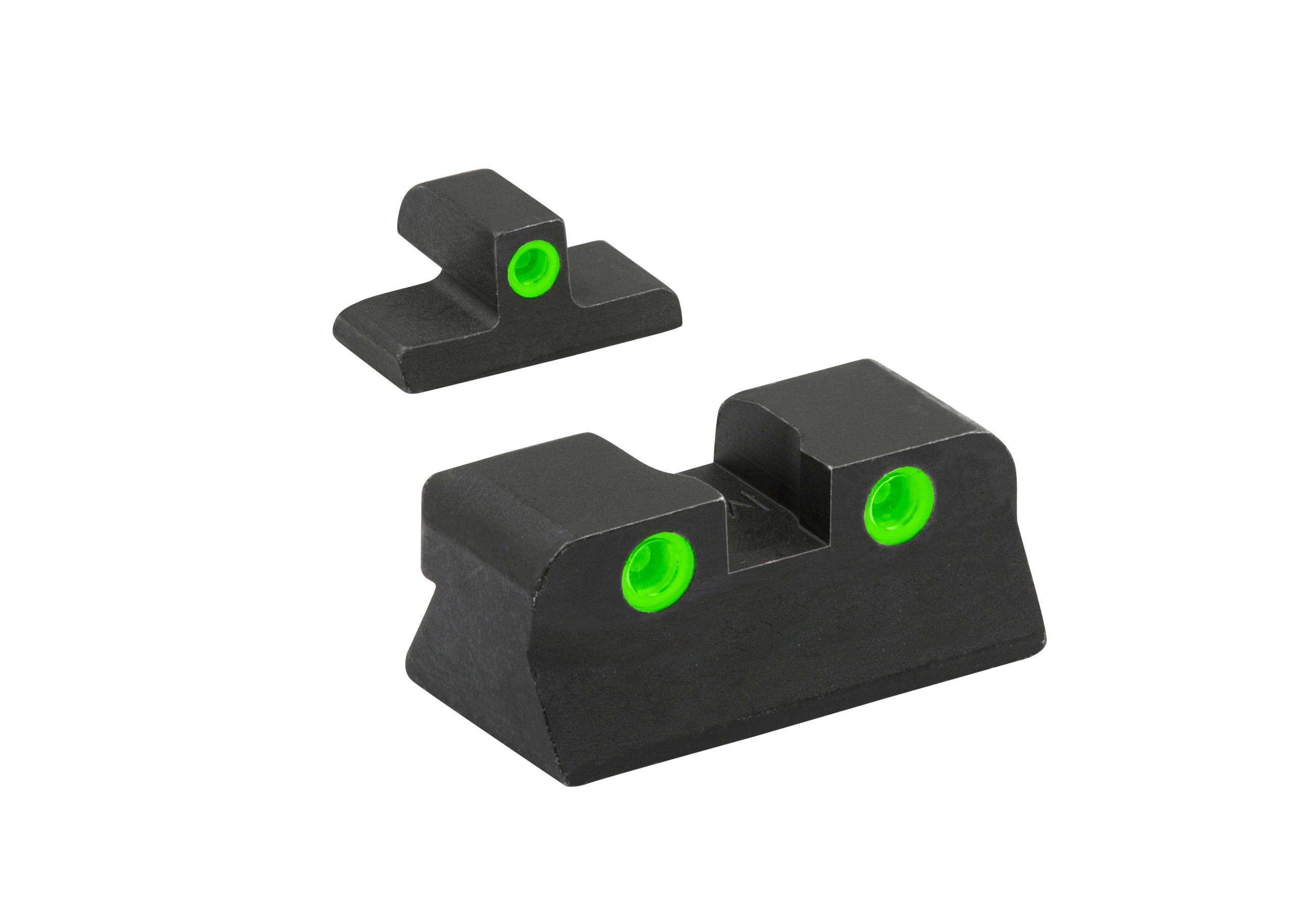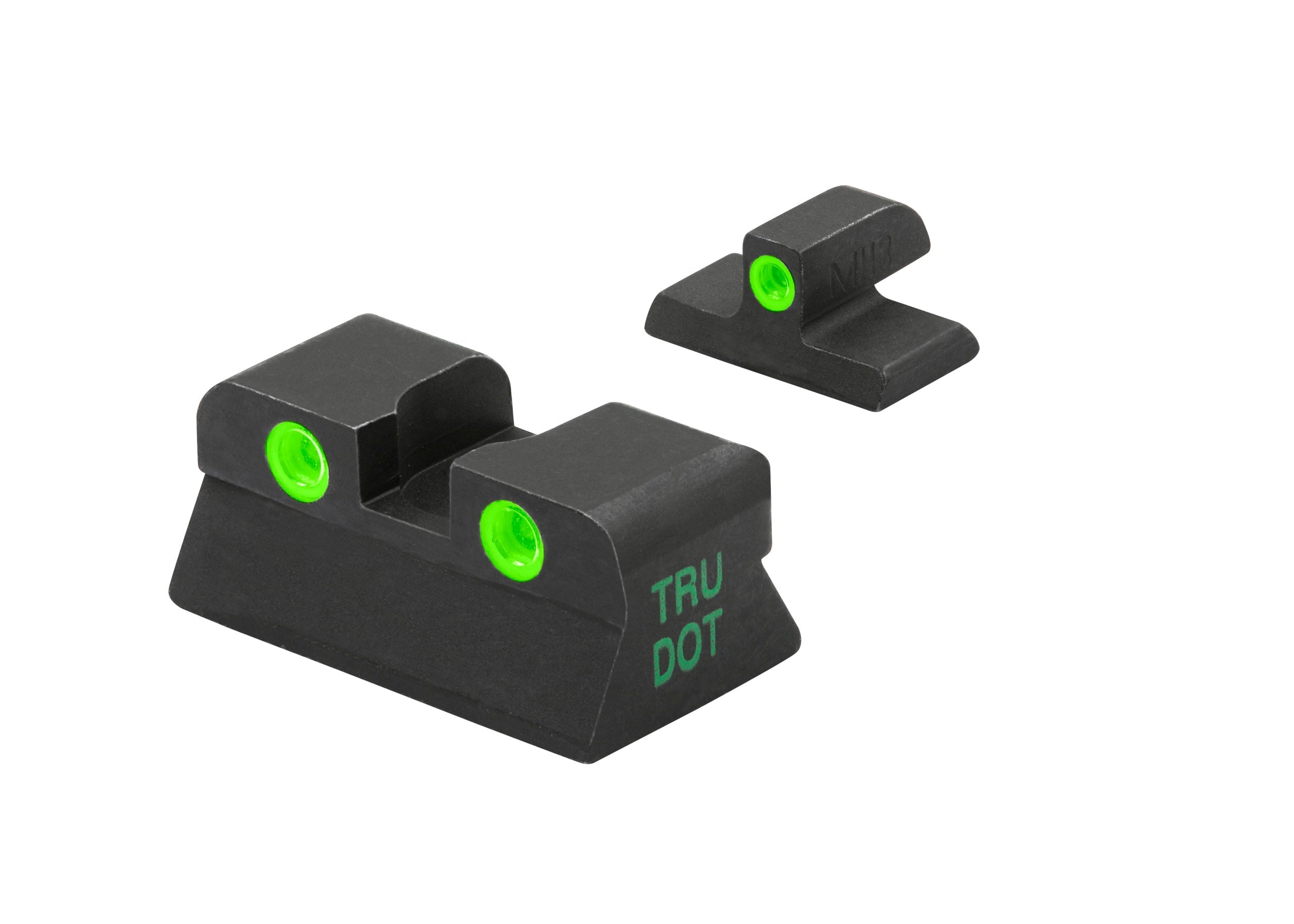Description
Meprolight Fixed Tru-Dot Night Sights for Browning Hi-Power Mark III provide a dependable solution for low-light shooting scenarios. With self-illuminating tritium technology, these sights require no batteries or switches, ensuring functionality at all hours. Their rugged design allows for reliable performance in various weather conditions, making them suitable for tactical training or competitive shooting. The Tru-Dot system enhances target acquisition, allowing for instinctive aiming that is crucial during high-pressure situations.
Backed by a 12-year usable illumination warranty, these night sights are a long-term investment for anyone seeking precision and reliability. Over 4.5 million systems are in use worldwide, a testament to their effectiveness. Users can expect a significant increase in hit capability, with marksmen reporting over an 85% improvement in performance.
Features – Key Benefits Bullets
- SELF-ILLUMINATED for consistent visibility without batteries or switches.
- WEATHERPROOF construction ensures reliable performance in all conditions.
- BRIGHTEST NIGHT SIGHTS available for superior low-light target acquisition.
- INTEGRATED DAY/NIGHT function allows for seamless use in varying light conditions.
- TRU-DOT® technology enables rapid and instinctive aiming.
- MAINTENANCE-FREE design reduces upkeep and extends usability.
- EASY INSTALLATION with no modifications required for your firearm.
- PROVEN TRACK RECORD with over 4.5 million units in service globally.
Technical Specifications
| Color: | Black |
| Fabric/Material: | Metal / Tritium |
| Front Material: | Tritium |
| Gun Type: | Pistol |
| Gun Make: | Browning |
| Illumination Type: | Tritium |
| Condition: | New |
What's in the Box?
- Meprolight Fixed Tru-Dot Night Sights
- Installation instructions
- 12-Year warranty documentation
Customer Reviews
"These sights are incredibly bright and work flawlessly in low light. Installation was a breeze!"
"I noticed a huge improvement in my accuracy at night. Highly recommend for any Browning owner."
"Tactical training has never been easier with these night sights. They truly live up to the hype!"
FAQ
How do Meprolight sights perform in low-light conditions? Meprolight sights utilize tritium for self-illumination, providing visibility even in complete darkness. This technology ensures that you can quickly acquire your target without needing any external light source.
Are these sights easy to install? Yes, these night sights are designed for easy installation, requiring no modifications to your Browning Hi-Power. The included instructions simplify the process, making it accessible for users of all experience levels.
How do they compare to other night sights on the market? Meprolight sights are known for their durability and brightness, outshining many competitors. With a 12-year warranty and proven performance, they offer excellent value and reliability for serious shooters.
Similar Models
Looking for additional options? Explore our full range of Meprolight night sights, including models tailored for other handguns and tactical applications. Whether you're looking for enhanced visibility or rugged durability, we have a variety of choices to meet your shooting needs.
Our Guarantees
FREE Fast Shipping Over $99
Enjoy complimentary expedited shipping on all orders over $99.
Secure Payments
Shop with confidence using our encrypted payment processing.
High Quality or Money Back
Not satisfied with your purchase? We'll refund your money, no questions asked.
Top-Notch Support
Our expert team is available to answer all your questions and provide assistance.
What Our Customers Say
Optics Knowledge Center
Understanding Rifle Scope Basics
Magnification
Magnification refers to how much larger an object appears through the scope compared to the naked eye. Fixed power scopes have one magnification setting, while variable power scopes offer a range (e.g., 3-9x).
Objective Lens
The objective lens is the front lens that gathers light. Larger objective lenses (measured in mm) gather more light, providing brighter images in low-light conditions but add weight and require higher mounting.
Reticle
The reticle (crosshair) is the aiming point inside the scope. Modern scopes offer various reticle designs, from simple duplex crosshairs to complex ballistic reticles with holdover points for different distances.
Adjustments
Rifle scopes have turrets for windage (horizontal) and elevation (vertical) adjustments. These are measured in MOA (minutes of angle) or MRAD (milliradians) and allow precise aiming adjustments.
Proper Scope Mounting Guide
Select the Right Rings & Base
Choose rings that match your scope's tube diameter (typically 1", 30mm, or 34mm). Select a base compatible with your rifle's receiver. For heavy-recoiling rifles, opt for stronger mounts.
Install the Base
Clean the receiver and base thoroughly. Apply a small amount of blue Loctite to the screws. Attach the base to the receiver and torque the screws to manufacturer specifications.
Attach the Rings
Attach the bottom halves of the rings to the base. Place the scope in the rings and loosely attach the top halves. Don't fully tighten yet.
Set Eye Relief & Level
Position the scope for proper eye relief (3-4 inches) in your normal shooting position. Ensure the reticle is level using a scope leveling tool. Once positioned correctly, tighten the rings evenly in a cross-pattern.
Scope Zeroing Tips
Start Close
Begin zeroing at a shorter distance (25-50 yards) to ensure you're on paper before moving to your desired zero distance (typically 100 yards).
Use a Stable Rest
Always zero your rifle from a stable shooting position using a bench rest, sandbags, or a shooting rest to eliminate as much human error as possible.
Fire Groups
Fire 3-shot groups before making adjustments. This provides a more accurate representation of where your rifle is shooting than single shots.
Make Deliberate Adjustments
Know your scope's adjustment values (typically 1/4 MOA per click). If your group is 2 inches low at 100 yards, you'll need to adjust up 8 clicks (for a 1/4 MOA scope).
Confirm Your Zero
After making adjustments, fire another group to confirm your zero. Repeat the process until your point of impact matches your point of aim.
Document Your Settings
Once zeroed, record your settings including distance, ammunition used, and environmental conditions for future reference.
Optics Maintenance & Care
Cleaning Lenses
- Start by blowing or brushing away loose particles
- Use a lens pen or microfiber cloth for fingerprints
- For stubborn dirt, use lens cleaning solution (never household cleaners)
- Clean with gentle circular motions from center outward
Protecting Your Optics
- Always use lens caps when not in use
- Store in a dry place with silica gel packets
- Avoid extreme temperature changes
- Use a quality scope cover in harsh conditions
Regular Maintenance
- Check and tighten mount screws periodically
- Inspect O-rings and seals for damage
- Verify zero after rough handling
- Clean the exterior with a damp cloth
What to Avoid
- Never use fingers to touch lenses
- Avoid paper products (tissues, paper towels) on lenses
- Don't use acetone, alcohol, or household cleaners
- Never disassemble your scope (voids warranty)





